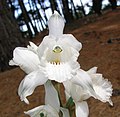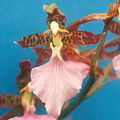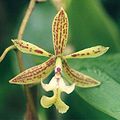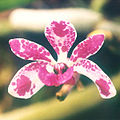Genera
As of July 2025, Plants of the World Online accepts 693 genera and several inter-generic hybrids. [3]
A




- Aa Rchb.f
- Acampe Lindl.
- Acanthophippium Blume
- Achlydosa M.A.Clem. & D.L.Jones
- Acianthera Scheidw.
- Acianthus R.Br.
- Acineta Lindl.
- Acriopsis Reinw. ex Blume
- Acrorchis Dressler
- Adamantinia Van den Berg & C.N.Gonç
- Adenochilus Hook.f.
- Adenoncos Blume
- Adrorhizon Hook.f.
- Aenhenrya Gopalan
- Aerangis Rchb.f.
- Aeranthes Lindl.
- Aerides Lour. – fox brush orchid
- Aeridostachya (Hook.f.) Brieger
- Aetheorhyncha Dressler
- Afropectinariella M.Simo & Stévart
- Aganisia Lindl.
- Aglossorrhyncha Schltr.
- Agrostophyllum Blume
- Alamania Lex.
- Alatiliparis Marg. & Szlach.
- Altensteinia Kunth.
- Ambrella H.Perrier
- Amesiella Schltr. ex Garay
- Amoana Leopardi & Carnevali
- × Anacamptiplatanthera P.Fourn. (Anacamptis × Platanthera)
- Anacamptis Rich.
- × Anacamptorchis E.G.Camus (Anacamptis × Orchis)
- Anathallis Barb.Rodr.
- Ancistrochilus Rolfe
- Ancistrorhynchus Finet
- Andinia (Luer) Luer
- Andreettaea Luer
- Angraecopsis Kraenzl.
- Angraecum Bory
- Anguloa Ruiz & Pav.
- Ania Lindl.
- Anoectochilus Blume – jeweled orchid
- Ansellia Lindl.
- Anthogonium Wall. ex Lindl.
- Aphyllorchis Blume
- Aplectrum (Nutt.) Torr. – Adam and Eve
- Aporostylis Rupp & Hatch
- Apostasia Blume
- Appendicula Blume
- Aracamunia Carnevali & I.Ramírez
- Arachnis Blume
- Archivea Christenson & Jenny
- Arethusa L. – dragon's mouth
- Arpophyllum Lex.
- Arthrochilus F.Muell.
- Artorima Dressler & G.E.Pollard
- Arundina Blume – bamboo orchid
- Aspasia Lindl.
- Aulosepalum Garay
- Auxopus Schltr.
B




- Bambuseria Schuit., Y.P.Ng & H.A.Pedersen
- Barbosella Schltr.
- Barkeria Knowles & Westc.
- Bartholina R.Br. – synonym of Holothrix Rich. ex Lindl.
- Basiphyllaea Schltr. – synonym of Bletia Ruiz & Pav. – crab orchid
- Baskervilla Lindl.
- Batemannia Lindl.
- Beclardia A.Rich.
- Beloglottis Schltr.
- × Bensteinia Christenson (Benzingia × Kefersteinia)
- Benthamia A.Rich.
- Benzingia Dodson
- Bhutanthera Renz – synonym of Herminium L.
- Bidoupia Aver., Ormerod & Duy
- Biermannia King & Pantl.
- Bifrenaria Lindl.
- Bipinnula Comm. ex Juss.
- Bletia Ruiz and Pav. – pine-pink
- Bletilla Rchb.f. – urn orchid
- Bogoria J.J.Sm.
- Bolusiella Schltr.
- Bonatea Willd.
- Brachionidium Lindl. – cup orchid
- Brachycorythis Lindl.
- Brachypeza Garay
- Brachystele Schltr.
- Braemia Jenny
- Brassavola R.Br. – daddy-long-legs
- Brassia R.Br. – cricket orchid
- × Brassocattleya Rolfe (Brassavola × Cattleya)
- Bromheadia Lindl.
- Broughtonia R.Br.
- Brownleea Harv. ex Lindl.
- Bryobium Lindl.
- Buchtienia Schltr.
- Bulbophyllum Thouars – rat-tail orchid
- Bulleyia Schltr. – synonym of Coelogyne
- Burnettia Lindl.
C












- Caladenia R.Br.
- Calanthe R.Br.
- Caleana R.Br.
- Callostylis Blume
- Calochilus R.Br. – bearded orchids
- Calopogon R.Br. – grasspink
- Caluera Dodson & Determann
- Calymmanthera Schltr.
- Calypso Salisb. – fairy-slipper orchid
- Calyptrochilum Kraenzl.
- Campanulorchis Brieger
- Campylocentrum Benth. – bent-spur orchid
- Capanemia Barb.Rodr.
- Cardiochilos P.J.Cribb
- Catasetum Rich. ex Kunth
- Cattleya Lindl.
- × Cattlianthe J.M.H.Shaw (Cattleya × Guarianthe)
- × Catyclia J.M.H.Shaw (Cattleya × Encyclia)
- Caucaea Schltr.
- Caularthron Raf.
- Centrostigma Schltr.
- Cephalanthera Rich. – some helleborines, phantom orchid
- × Cephalopactis Asch. & Graebn. (Cephalanthera × Epipactis)
- × Cephalorchis F.M.Vázquez (Cephalanthera × Orchis)
- Ceratandra Lindl.
- Ceratocentron Senghas
- Ceratostylis Blume
- Chamaeanthus Schltr.
- Chamaegastrodia Makino & F.Maek.
- Chamelophyton Garay
- × Chamodenia Peitz (Chamorchis × Gymnadenia)
- Chamorchis Rich.
- Changnienia S.S.Chien
- Chaubardia Rchb.f.
- Chaubardiella Garay
- Cheiradenia Lindl.
- Cheirostylis Blume
- Chelonistele Pfitzer – synonym of Coelogyne Lindl.
- Chiloglottis R.Br.
- Chiloschista Lindl.
- Chloraea Lindl.
- Chondrorhyncha Lindl.
- Chondroscaphe (Dressler) Senghas & G.Gerlach
- Chroniochilus J.J.Sm.
- Chrysoglossum Blume
- Chysis Lindl.
- Chytroglossa Rchb.f.
- Cirrhaea Lindl.
- Cischweinfia Dressler & N.H.Williams
- Claderia Hook.f.
- Cleisocentron Brühl
- Cleisomeria Lindl. ex G.Don
- Cleisostoma Blume
- Cleisostomopsis Seidenf.
- Cleistes Rich. ex Lindl.
- Cleistesiopsis Pansarin & F.Barros – rosebud orchid
- Clematepistephium N.Hallé
- Clowesia Lindl.
- Coccineorchis Schltr.
- Cochleanthes Raf. – fan-shape orchid
- × Cochlezella J.M.H.Shaw (Cochleanthes × Warczewiczella)
- Codonorchis Lindl.
- Coelia Lindl.
- Coeliopsis Rchb.f.
- Coelogyne Lindl.
- Coenoemersa R.González & Lizb.Hern.
- Coilochilus Schltr.
- Collabium Blume
- Comparettia Poepp. & Endl. – snail orchid
- Constantia Poepp. & Endl.
- Cooktownia D.L.Jones
- Corallorhiza Gagnebin – coral root
- Coryanthes Hook. – bucket orchids
- Corybas Salisb.
- Corycium Sw.
- Corymborkis Thouars – crow orchid
- Cottonia Wight
- Cotylolabium Garay
- Cranichis Sw. – helmet orchid
- Cremastra Lindl.
- Crepidium Blume
- Crossoglossa Dressler & Dodson
- Crossoliparis Marg.
- Cryptarrhena R.Br.
- Cryptochilus Wall.
- Cryptopus Lindl.
- Cryptopylos Garay – synonym of Macropodanthus L.O.Williams
- Cryptostylis R.Br.
- Cuitlauzina Lex.
- Cyanaeorchis Barb.Rodr.
- Cyanicula Hopper & A.P.Br. – synonym of Caladenia R.Br.
- × Cyanthera Hopper & A.P.Br. (Cyanicula × Elythranthera)
- Cybebus Garay
- Cyclopogon C.Presl. ladies'-tresses
- Cycnoches Lindl. – swan orchids
- Cylindrolobus Blume
- Cymbidium Sw.
- Cymbilabia D.K.Liu & Ming H.Li
- Cymboglossum (Schltr.) Rauschert
- Cynorkis Thouars
- Cypholoron Dodson & Dressler
- Cypripedium L. – lady's slipper
- Cyrtochiloides N.H.Williams & M.W.Chase
- Cyrtochilum Kunth
- Cyrtopodium R.Br. – cow-horn orchid
- Cyrtorchis Schltr.
- Cyrtosia Blume
- Cyrtostylis R.Br.
- Cystorchis Blume
D
- × Dactylanthera P.F.Hunt & Summerh. (Dactylorhiza × Platanthera)
- × Dactylocamptis P.F.Hunt & Summerh. (Anacamptis × Dactylorhiza)
- × Dactylodenia Garay & H.R.Sweet (Dactylorhiza × Gymnadenia)
- Dactylorhiza Neck. ex Nevski – key flower
- Dactylostalix Rchb.f.
- Daiotyla Dressler
- Danhatchia Garay & Christenson
- Danxiaorchis J.W.Zhai, F.W.Xing & Z.J.Liu
- Deceptor Seidenf.
- Degranvillea Determann
- Deiregyne Schltr.
- Dendrobium Blume
- Dendrochilum Blume – synonym of Coelogyne Lindl.
- Dendrolirium Blume
- Dendrophylax Rchb.f.
- Devogelia Schuit.
- Diaphananthe Schltr.
- Diceratostele Summerh.
- Dichaea Lindl. – leafy-stem orchid, leaf-stem orchid
- Dichromanthus Garay
- Dickasonia L.O.Williams – synonym of Coelogyne Lindl.
- Didymoplexiella Garay
- Didymoplexiopsis Seidenf.
- Didymoplexis Griff.
- Dienia Lindl.
- Diglyphosa Blume
- Dilochia Lindl.
- Dilochiopsis (Hook.f.) Brieger
- Dilomilis Raf. – parrot-beak orchid
- Dimerandra Schltr.
- Dimorphorchis Rolfe
- Dinema Lindl.
- Dinklageella Mansf.
- Diodonopsis Pridgeon & M.W.Chase
- Diplocentrum Lindl.
- Diplomeris D.Don
- Diploprora Hook.f.
- Dipodium R.Br.
- Disa P.J.Bergius
- Discyphus Schltr.
- Disperis Sw.
- Diuris Sm.
- Domingoa Schltr. – Mona
- Dossinia C.Morren
- Dracomonticola H.P.Linder & Kurzweil
- Draconanthes (Luer) Luer
- Dracula Luer
- Drakaea Lindl.
- Dresslerella Luer
- Dressleria Dodson
- Dryadella Luer
- Dryadorchis Schltr.
- Drymoanthus Nicholls
- Duckeella Porto & Brade
- Dunstervillea Garay
- Dyakia Christenson
E



- Earina Lindl.
- Echinorhyncha Dressler
- Echinosepala Pridgeon & M.W.Chase
- Eclecticus P.O'Byrne
- Eggelingia Summerh.
- Eleorchis F.Maek.
- Elleanthus C.Presl. – tiger orchid, praying-virgin
- Eloyella P.Ortiz – synonym of Dunstervillea Garay
- Eltroplectris Raf. – long-claw orchid
- Elythranthera (Endl.) A.S.George – synonym of Caladenia R.Br.
- Embreea Dodson
- Encyclia Hook. – butterfly orchid
- Entomophobia de Vogel – synonym of Coelogyne Lindl.
- Ephippianthus Rchb.f.
- Epiblastus Schltr.
- Epiblema R.Br.
- Epidendrum L. – star orchid
- Epipactis Zinn – helleborine
- Epipogium Borkh.
- Epistephium Kunth
- Erasanthe P.J.Cribb, Hermans & D.L.Roberts
- Eria Lindl.
- Eriaxis Rchb.f.
- Eriochilus R.Br.
- Eriodes Rolfe
- Eriopsis Lindl.
- Erycina Lindl.
- Erythrodes Blume – false helmet orchids
- Erythrorchis Blume
- Espinhassoa Salazar & J.A.N.Bat.
- Eulophia R.Br. – Wildcoco
- Euryblema Dressler
- Eurycentrum Schltr.
- Eurychone Schltr.
- Eurystyles Wawra – custard orchid
- Evotella Kurzweil & H.P.Linder
F
- Fernandezia Ruiz & Pav.
- Frondaria Luer
- Fuertesiella Schltr.
- Funkiella Schltr.
G



- Galeandra Lindl. – hooded orchid
- Galearis Raf. – showy orchid
- Galeoglossum A.Rich. & Galeotti
- Galeola Lour.
- Galeottia A.Rich.
- Galeottiella Schltr.
- Gastrochilus D.Don
- Gastrodia R.Br.
- Gavilea Poepp.
- Gennaria Parl.
- Genoplesium R.Br.
- Geodorum Andrews – synonym of Eulophia R.Br.
- Glomera Blume
- Glossodia R.Br. – synonym of Caladenia R.Br.
- Gomesa R.Br.
- Gomphichis Lindl.
- Gonatostylis Schltr.
- Gongora Ruiz & Pav.
- Goodyera R.Br. – rattlesnake plantain
- Govenia Lindl. – govenia
- Grammangis Rchb.f.
- Grammatophyllum Blume
- GrandiphyllumDocha Neto – synonym of Trichocentrum Poepp. & Endl.
- Graphorkis Thouars
- Gravendeelia Bogarín & Karremans
- Greenwoodiella Salazar, Hern.-López & J.Sharma
- Grobya Lindl.
- Grosourdya Rchb.f.
- Guanchezia G.A.Romero & Carnevali – synonym of Bifrenaria Lindl.
- Guarianthe Dressler & W.E.Higgins
- Gunnarella Senghas – synonym of Bogoria J.J.Sm.
- Gymnadenia R.Br. – fragrant orchid
- × Gymnanacamptis Asch. & Graebn. (Anacamptis × Gymnadenia)
- × Gymnotraunsteinera Cif. & Giacom. (Gymnadenia × Traunsteinera)
- × Gymplatanthera L.C.Lamb. (Gymnadenia × Platanthera)
- Gynoglottis J.J.Sm. – synonym of Coelogyne Lindl.
H

- Habenaria Willd. – bog orchid, false rein orchid
- Hagsatera R.González
- Halleorchis Szlach. & Olszewski
- Hammarbya Kuntze
- Hancockia Rolfe
- Hapalorchis Schltr.
- Hederorkis Thouars
- Helleriella A.D.Hawkes – dotted orchid
- Helonoma Garay
- Hemipilia Lindl.
- Herminium L.
- Herpysma Lindl.
- Hetaeria Blume
- Hexalectris Raf. – crested coralroot – synonym of Bletia Ruiz & Pav.
- Himantoglossum Spreng.
- Hintonella Ames
- Hippeophyllum Schltr. – synonym of Oberonia Lindl.
- Hoehneella Ruschi
- Hofmeisterella Rchb.f.
- Holcoglossum Schltr.
- × Holcosia J.M.H.Shaw (Holcoglossum × Luisia)
- Holothrix Rich. ex Lindl.
- Homalopetalum Rolfe
- Horichia Jenny
- Horvatia Garay – synonym of Bifrenaria Lindl.
- Houlletia Brongn.
- Hsenhsua X.H.Jin, Schuit. & W.T.Jin
- Huntleya Bateman ex Lindl.
- Huttonaea Harv.
- Hylophila Lindl.
- Hymenorchis Schltr.
I
J
- Jacquiniella Schltr. – tufted orchid
- Jejewoodia Szlach.
- Jumellea Schltr.
K
- Karma Karremans
- Kefersteinia Rchb.f.
- Kegeliella Mansf.
- Kionophyton Garay
- Kipandiorchis P.O'Byrne & Gokusing
- Koellensteinia Rchb.f. – grass-leaf orchid
- Kraenzlinella Kuntze – synonym of Acianthera Scheidw.
- Kuhlhasseltia J.J.Sm. – synonym of Odontochilus Blume
- Kylicanthe Descourv., Stévart & Droissart
L



- Lacaena Lindl.
- Laelia Lindl.
- × Laeliocattleya Rolfe (Cattleya × Laelia)
- Lankesterella Ames
- Lankesteriana Karremans
- Lecanorchis Blume
- Lemurella Schltr.
- Lemurorchis Kraenzl.
- Leochilus Knowles & Westc. – smooth-lip orchid
- Lepanthes Sw. – babyboot orchid
- Lepanthopsis (Cogn.) Ames – tiny orchid
- Lepidogyne Blume
- Leporella A.S.George
- Leptoceras (R.Br.) Lindl.
- Leptotes Lindl.
- Limodorum Boehm.
- Liparis Rich. – wide-lip orchid
- Listrostachys Rchb.f.
- Lockhartia Hook.
- Loefgrenianthus Hoehne
- Ludisia A.Rich. – jewel orchid
- Lueckelia Jenny
- Lueddemannia Linden and Rchb.f.
- Luisia Gaudich.
- × Lycamerlycaste J.M.H.Shaw (Lycaste × Sudamerlycaste)
- Lycaste Lindl. – bee orchid
- × Lycida Oakeley (Ida × Lycaste)
- Lycomormium Rchb.f.
- Lyperanthus R.Br.
- Lyroglossa Schltr.
M






- Macodes Lindl.
- Macradenia R.Br. – long-gland orchid
- Macroclinium Barb.Rodr.
- Macropodanthus L.O.Williams
- Madisonia Luer
- Malaxis Sol. ex Sw. – adder's mouth orchid
- Manniella Rchb.f.
- Masdevallia Ruiz & Pav.
- Maxillaria Ruiz & Pav. – tiger orchid, flame orchid
- Mediocalcar J.J.Sm.
- Megalorchis H.Perrier
- Megastylis (Schltr.) Schltr.
- Meiracyllium Rchb.f.
- † Meliorchis extinct, 80-million-year-old orchid
- Mengzia W.C.Huang, Z.J.Liu & C.Hu
- Mesadenella Pabst & Garay
- Mesadenus Schltr. – ladies'-tresses
- Mexipedium V.A.Albert & M.W.Chase
- Microchilus C.Presl.
- Microcoelia Lindl.
- Microepidendrum Brieger ex W.E.Higgins
- Micropera Lindl.
- Microsaccus Blume
- Microthelys Garay
- Microtis R.Br.
- Miltonia Lindl.
- × Miltonidium C.H.Curtis (Miltonia × Oncidium)
- Miltoniopsis God.-Leb. -pansy orchid
- Mobilabium Rupp
- Monophyllorchis Schltr.
- Mormodes Lindl.
- Mycaranthes Blume
- Myoxanthus Poepp. & Endl.
- Myrmechis Blume – synonym of Odontochilus Blume
- × Myrmecolaelia F.Hanb. ex Rolfe (Laelia × Myrmecophila)
- Myrmecophila Rolfe
- Myrosmodes Rchb.f.
- Mystacidium Lindl.
N
- Nabaluia Ames – synonym of Coelogyne Lindl.
- Nemaconia Knowles & Westc.
- Neobathiea Schltr.
- Neobolusia Schltr.
- Neocogniauxia Schltr.
- Neogardneria Schltr. ex Garay
- Neogyna Rchb.f. – synonym of Coelogyne Lindl.
- Neomoorea Rolfe
- × Neotinacamptis J.M.H.Shaw (Anacamptis × Neotinea)
- × Neotinarhiza J.M.H.Shaw (Dactylorhiza × Neotinea)
- Neotinea Rchb.f.
- Neottia Guett.
- Nephelaphyllum Blume
- Nephrangis (Schltr.) Summerh.
- Nervilia Comm. ex Gaudich.
- Neuwiedia Blume
- Nidema Britton & Millsp. – fairy orchid
- Nohawilliamsia M.W.Chase & Whitten
- Nothostele Garay
- Notylia Lindl.
- Notyliopsis P.Ortiz
O



- Oberonia Lindl.
- Oberonioides Szlach.
- Octarrhena Thwaites
- Octomeria R.Br.
- Odontochilus Blume
- Odontorrhynchus M.N.Correa
- Oeceoclades Lindl. – synonym of Eulophia R.Br. – monk orchid
- Oeonia Lindl.
- Oeoniella Schltr.
- Oestlundia W.E.Higgins
- Oligophyton H.P.Linder
- Oliveriana Rchb.f.
- Omoea Blume
- Oncidium Sw. – dancing-lady orchid
- Ophidion Luer
- Ophioglossella Schuit. & Ormerod
- Ophrys L. – ophrys
- Opilionanthe Karremans & Bogarín
- × Orchidactylorhiza Soó & Borsos (Dactylorhiza × Orchis)
- × Orchigymnadenia E.G.Camus (Gymnadenia × Orchis)
- × Orchimantoglossum Asch. & Graebn. (Himantoglossum × Orchis)
- × Orchinea J.M.H.Shaw (Neotinea × Orchis)
- Orchipedum Breda
- × Orchiplatanthera E.G.Camus (Orchis × Platanthera)
- Orchis Tourn. ex L. – orchis
- Oreorchis Lindl.
- Orestias Ridl.
- Orleanesia Barb.Rodr.
- Ornithocephalus Hook.
- Orthoceras R.Br.
- Otochilus Lindl. – synonym of Coelogyne Lindl.
- Otoglossum (Schltr.) Garay & Dunst.
- Otostylis Schltr.
- Oxystophyllum Blume
P







- Pabstia Garay
- Pabstiella Brieger & Senghas
- Pachites Lindl.
- Pachyplectron Schltr.
- Pachystoma Blume
- Palmorchis Barb.Rodr.
- Panisea (Lindl.) Lindl. – synonym of Coelogyne Lindl.
- Paphinia Lindl.
- Paphiopedilum Pfitzer – Venus' slipper
- Papilionanthe Schltr.
- Papillilabium Dockrill – synonym of Plectorrhiza Dockrill
- Papuaea Schltr.
- Paradisanthus Rchb.f.
- Paraphalaenopsis A.D.Hawkes
- Pecteilis Raf.
- Pelatantheria Ridl.
- Pelexia Poit. ex Lindl. – hachuela
- Pendusalpinx Karremans & Mel.Fernández
- Pennilabium J.J.Sm.
- Peristeranthus T.E.Hunt
- Peristeria Hook.
- Peristylus Blume
- Pescatoria Rchb.f.
- Phaius Lour. – nun's-hood orchid – synonym of Calanthe R.Br.
- Phalaenopsis Blume – moth orchid
- Pheladenia D.L.Jones & M.A.Clem.
- Phloeophila Hoehne & Schltr.
- Pholidota Lindl. – synonym of Coelogyne Lindl.
- Phragmipedium Rolfe
- Phragmorchis L.O.Williams
- Phreatia Lindl.
- Phymatidium Lindl.
- Physogyne Garay
- Pilophyllum Schltr.
- Pinalia Lindl.
- Piperia Rydb. – rein orchid – synonym of Platanthera Rich.
- Platanthera Rich. – fringed orchid, bog orchid
- Platycoryne Rchb.f.
- Platylepis A.Rich.
- Platyrhiza Barb.Rodr.
- Platystele Schltr.
- Plectorrhiza Dockrill
- Plectrelminthus Raf.
- Plectrophora H.Focke
- Pleione D.Don
- Pleurothallis R.Br. – bonnet orchid
- Pleurothallopsis Porto & Brade
- Plocoglottis Blume
- Poaephyllum Ridl.
- Podangis Schltr.
- Podochilus Blume
- Pogonia Juss. – snake-mouth orchid
- Pogoniopsis Rchb.f.
- Polycycnis Rchb.f.
- Polyotidium Garay
- Polystachya Hook.
- Pomatocalpa Breda
- Ponera Lindl.
- Ponthieva R.Br. – shadow witch
- Porpax Lindl.
- Porphyroglottis Ridl.
- Porphyrostachys Rchb.f.
- Porroglossum Schltr.
- Porrorhachis Garay
- Praecoxanthus Hopper & A.P.Br.
- Prasophyllum R.Br.
- Prescottia Lindl. – Prescott orchid
- Pridgeonia Pupulin
- Promenaea Lindl.
- Prosthechea Knowles & Westc.
- × Pseudadenia P.F.Hunt (Gymnadenia × Pseudorchis)
- Pseuderia Schltr.
- × Pseudinium P.F.Hunt (Herminium × Pseudorchis)
- Pseudocentrum Lindl.
- Pseudogoodyera Schltr.
- Pseudolaelia Porto & Brade
- Pseudorchis Ség.
- × Pseudorhiza P.F.Hunt (Dactylorhiza × Pseudorchis)
- Pseudovanilla Garay
- Psilochilus Barb.Rodr. – ragged-lip orchid
- Psychilis Raf. – peacock orchid
- Psychopsiella Lückel & Braem
- Psychopsis Raf. – butterfly orchid
- × Psytonia J.M.H.Shaw (Broughtonia × Psychilis)
- Pterichis Lindl.
- Pteroceras Hasselt ex Hassk.
- Pteroglossa Schltr.
- Pterostemma Kraenzl.
- Pterostylis R.Br.
- Pterygodium Sw.
- Pupulinia Karremans & Bogarín
- Pygmaeorchis Brade
- Pyrorchis D.L.Jones & M.A.Clem.
Q
R




- Rangaeris (Schltr.) Summerh.
- Rauhiella Pabst & Braga
- Renanthera Lour.
- Restrepia Kunth
- Restrepiella Garay & Dunst.
- Rhaesteria Summerh. – synonym of Rhipidoglossum Schltr.
- Rhinerrhiza Rupp
- Rhipidoglossum Schltr.
- Rhizanthella R.S.Rogers
- Rhomboda Lindl.
- Rhynchogyna Seidenf. & Garay
- Rhyncholaelia Schltr.
- Rhynchostele Rchb.f.
- Rhynchostylis Blume
- Ridleyella Schltr.
- Rimacola Rupp
- Risleya King & Pantl.
- Robiquetia Gaudich
- Rodriguezia Ruiz & Pav.
- Roeperocharis Rchb.f.
- Rossioglossum (Schltr.) Garay & G.C.Kenn.
- Rudolfiella Hoehne – synonym of Bifrenaria Lindl.
S
- Saccolabiopsis J.J.Sm.
- Saccolabium Blume
- Sacoila Raf. – terrestrial orchid
- Sanderella Kuntze
- Santotomasia Ormerod
- Sarcanthopsis Garay
- Sarcochilus R.Br.
- Sarcoglottis C.Presl.
- Sarcoglyphis Garay
- Sarcophyton Garay
- Satyrium Sw.
- SaundersiaRchb.f. – synonym of Trichocentrum Poepp. & Endl.
- Sauroglossum Lindl.
- Scaphosepalum Pfitzer
- Scaphyglottis Poepp. & Endl. – Malaysian orchid
- Schiedeella Schltr.
- Schizochilus Sond.
- Schlimia Planch. & Linden
- Schoenorchis Blume
- Schuitemania Ormerod
- Schunkea Senghas
- Scuticaria Lindl. – synonym of Bifrenaria Lindl.
- Seegeriella Senghas
- Seidenfadenia Garay
- Selenipedium Rchb.f.
- Serapias L.
- × Serapicamptis Godfery (Anacamptis × Serapias)
- × Serapirhiza Potucek (Dactylorhiza × Serapias)
- Sertifera Lindl. ex Rchb.f.
- Sievekingia Rchb.f.
- Silvorchis J.J.Sm.
- Sirhookera Kuntze
- Sirindhornia H.A.Pedersen & Suksathan
- Skeptrostachys Garay
- Smithsonia C.J.Saldanha
- Smitinandia Holttum
- Sobennikoffia Schltr.
- Sobralia Ruiz & Pav.
- Solenangis Schltr.
- Solenidium Lindl.
- Solenocentrum Schltr.
- Soterosanthus F.Lehm. ex Jenny
- Sotoa Salazar
- Spathoglottis Blume – ground orchid
- Specklinia Lindl.
- Sphyrarhynchus Mansf.
- Spiculaea Lindl.

- Spiranthes Rich. ladies'-tresses
- Stalkya Garay
- Stanhopea J.Frost ex Hook.
- Stelis Sw. – leach orchid
- Stellamaris Mel.Fernández & Bogarín
- Stenia Lindl.
- Stenoglottis Lindl.
- Stenoptera C.Presl.
- Stenorrhynchos Rich. ex Spreng. – ladies'-tresses
- Stenotyla Dressler
- Stereochilus Lindl.
- Stereosandra Blume
- Steveniella Schltr.
- Stichorkis Thouars
- Stigmatodactylus Maxim. ex Makino
- Strongyleria (Pfitzer) Schuit., Y.P.Ng & H.A.Pedersen
- Suarezia Dodson
- Summerhayesia P.J.Cribb
- Sutrina Lindl.
- Svenkoeltzia Burns-Bal.
- Systeloglossum Schltr.
T
- Taeniophyllum Blume
- Taeniorrhiza Summerh. – synonym of Microcoelia Lindl.
- Tainia Blume
- Tamayorkis Szlach.
- Taprobanea Christenson
- Teagueia (Luer) Luer
- Telipogon Kunth
- Tetramicra Lindl. – wallflower orchid
- Teuscheria Garay – synonym of Bifrenaria Lindl.
- Thaia Seidenf.
- Thecopus Seidenf.
- Thecostele Rchb.f.
- Thelasis Blume
- Thelymitra J.R.Forst. & G.Forst.
- Thelyschista Garay
- Thrixspermum Lour.
- Thulinia P.J.Cribb
- Thunia Rchb.f.
- Thuniopsis L.Li, D.P.Ye & Shi J.Li
- Thysanoglossa Porto & Brade
- Tipularia Nutt. – crippled-cranefly
- Tolumnia Raf. – dancing-lady orchid, variegated orchid
- Tomzanonia Nir
- Townsonia Cheeseman
- Trachoma Garay
- Traunsteinera Rchb.
- Trevoria F.Lehm.
- Triceratorhynchus Summerh.
- Trichocentrum Poepp. & Endl.
- Trichoceros Kunth
- Trichoglottis Blume
- Trichopilia Lindl.
- Trichosalpinx Luer – bonnet orchid
- Trichotosia Blume
- Tridactyle Schltr.
- Triphora Nutt. – noddingcaps
- Trisetella Luer
- Trizeuxis Lindl.
- Tropidia Lindl. – palm orchid
- Tsaiorchis Tang & F.T.Wang
- Tuberolabium Yamam.
- Tylostigma Schltr.
U
- Uleiorchis Hoehne
- Uncifera Lindl.
V
- Vanda R.Br.
- × Vandoglossum Garay (Holcoglossum × Vanda)
- Vandopsis Pfitzer
- Vanilla Plum. ex Mill. – vanilla
- Vargasiella C.Schweinf.
- Vasqueziella Dodson
- Veyretella Szlach. & Olszewski
- Veyretia Szlach.
- Vitekorchis Romowicz & Szlach.
- Vrydagzynea Blume
W
- Waireia D.L.Jones, Molloy & M.A.Clem.
- Warczewiczella Rchb.f.
- Warrea Lindl.
- Warreella Schltr.
- Warreopsis Garay
- Wullschlaegelia Rchb.f. – leafless orchid
X
Y
Z
- Zelenkoa M.W.Chase & N.H.Williams
- Zeuxine Lindl. – soldier's orchid
- Zootrophion Luer
- Zygopetalum Hook.
- Zygosepalum Rchb.f.
- Zygostates Lindl.
- Epidendrum ibaguense
- Epidendrum parkinsonianum
- Epidendrum stamfordianum
- Maxillaria rufescens
- Maxillaria tenuifolia
- Rhynchostlis gigantea
- Sarcochilus hartmannii
- Schomburgkia undulata
- Late-flowering ladies'-tresses (Spiranthes magnicamporum)
- Nodding ladies'-tresses (Spiranthes cernua)
- Stenoglottis longifolia
- Moon orchid (Phalaenopsis amabilis)
- Dendrobium hybrid
- Phantom orchid (Cephalanthera rubra var. alba)
- Thrixspermum saruwatarii
- Early Purple orchid (Orchis mascula)















